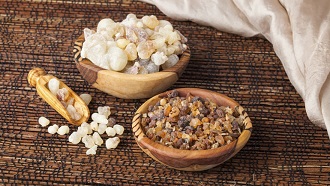Nhũ Hương và Mộc Dược

Frankincense and myrrh are both resins extracted from trees in the Burseraceae family, also known as the torchwood or incense family. Frankincense comes from the dried sap of Boswellia trees, while myrrh comes from the lifeblood of the Commiphora. Extracting the sap is a tenuous dance—you must injure the tree without killing it. If done properly, the wound will stimulate a process called “gummosis,” which is exactly what it sounds like: the tree tries to gum up the damage, and you can carve off the resulting ooze for your own uses.
Burseraceae may be associated with the ancient world, but it’s still found in tropical regions from Africa and Asia to Central and South America. “Wherever I go,” Daly says, “they’re all used for the same thing… by people who never had any contact.” Everything from the bark of the tree to the sap inside is fragrant, so both frankincense and myrrh are used as incense and perfume. Historically, myrrh was also an embalming fluid—hence Hapshetsut’s dogged interest in the plant. Both have religious value; they were melted to honor the gods and ward off evil spirits. But, Daly says, they also have deeply practical uses, even today.”You find that people use the frankincense and myrrh plant for dozens if not hundreds of purposes, from helping you get pregnant to helping your cows produce milk,” he says. Mixed with other compounds, the resin can even seal the broken hull of a boat. “It’s bewildering the number of uses they have,” Daly says.
Tác giả:Duy Nguyen

